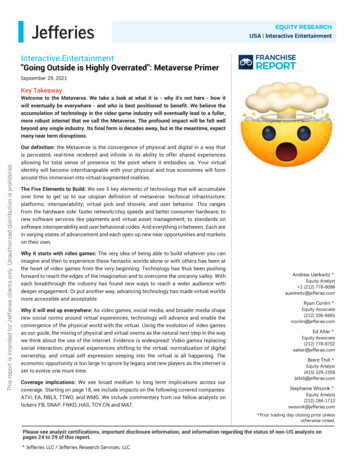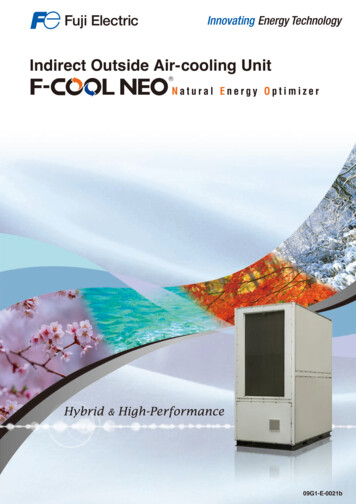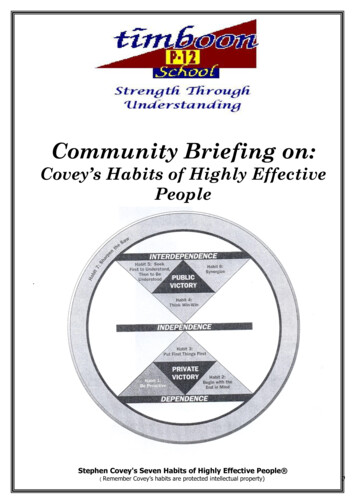
Transcription
EQUITY RESEARCHUSA Interactive EntertainmentInteractive Entertainment"Going Outside is Highly Overrated": Metaverse PrimerSeptember 29, 2021Key TakeawayThis report is intended for Jefferies clients only. Unauthorized distribution is prohibited.Welcome to the Metaverse. We take a look at what it is - why it's not here - how itwill eventually be everywhere - and who is best positioned to benefit. We believe theaccumulation of technology in the video game industry will eventually lead to a fuller,more robust internet that we call the Metaverse. The profound impact will be felt wellbeyond any single industry. Its final form is decades away, but in the meantime, expectmany near term disruptions.Our definition: the Metaverse is the convergence of physical and digital in a way thatis persistent, real-time rendered and infinite in its ability to offer shared experiencesallowing for total sense of presence to the point where it embodies us. Your virtualidentity will become interchangeable with your physical and true economies will formaround this immersion into virtual/augmented realities.The Five Elements to Build: We see 5 key elements of technology that will accumulateover time to get us to our utopian definition of metaverse: technical infrastructure;platforms; interoperability; virtual pick and shovels; and user behavior. This rangesfrom the hardware side: faster network/chip speeds and better consumer hardware; tonew software services like payments and virtual asset management; to standards onsoftware interoperability and user behavioral codes. And everything in between. Each arein varying states of advancement and each open up new near opportunities and marketson their own.Why it starts with video games: The very idea of being able to build whatever you canimagine and then to experience these fantastic worlds alone or with others has been atthe heart of video games from the very beginning. Technology has thus been pushingforward to reach the edges of the imagination and to overcome the uncanny valley. Witheach breakthrough the industry has found new ways to reach a wider audience withdeeper engagement. Or put another way, advancing technology has made virtual worldsmore accessible and acceptable.Why it will end up everywhere: As video games, social media, and broader media shapenew social norms around virtual expereinces, technology will advance and enable theconvergence of the physical world with the virtual. Using the evolution of video gamesas our guide, the mixing of physical and virtual seems as the natural next step in the waywe think about the use of the internet. Evidence is widespread: Video games replacingsocial interaction, physical experiences shifting to the virtual, normalization of digitalownership, and virtual self expression seeping into the virtual is all happening. Theeconomic opportunity is too large to ignore by legacy and new players as the internet isset to evolve one more time.Coverage implications: We see broad medium to long term implications across ourcoverage. Starting on page 18, we include impacts on the following covered companies:ATVi, EA, RBLX, TTWO, and WMG. We include commentary from our fellow analysts ontickers FB, SNAP, FNKO, HAS, TOY CN and MAT.Andrew Uerkwitz *Equity Analyst 1 (212) 778-8098auerkwitz@jefferies.comRyan Conlin *Equity Associate(212) 336-6665rconlin@jefferies.comEd Alter *Equity Associate(212) 778-8702ealter@jefferies.comBrent Thill *Equity Analyst(415) 229-1559bthill@jefferies.comStephanie Wissink *Equity Analyst(212) 284-1713swissink@jefferies.com Prior trading day closing price unlessotherwise noted.Please see analyst certifications, important disclosure information, and information regarding the status of non-US analysts onpages 24 to 29 of this report.* Jefferies LLC / Jefferies Research Services, LLC
EQUITY RESEARCHUSA Interactive EntertainmentUtopian Definition of MetaverseEveryone has a definition for the metaverse, so why can't we? We have avoided writingspecifically about the topic as we find it too broad a term as well as something we don'tsee as new. Video games are often leading indicators of broader consumer trends andengagement tools. However, we do believe while there has long been and will continue tobe an accumulation of technology leading to some utopian world we will eventually calla metaverse, there has been recent breakthroughs that have come together to bring thisword to the forefront. Let's step over the void and get started. Here are some definitionswe found interesting in our research.This report is intended for Jefferies clients only. Unauthorized distribution is prohibited."The Metaverse is an expansive network of persistent, real-time rendered 3D worldsand simulations that support continuity of identity, objects, data and entitlements,and can be experienced synchronously by an effectively unlimited number ofusers, each with an individual sense of presence." - Matthew Ball (VC, Essayist)"A nebulous, digitally mixed reality with both non-fungible and infinite items andpersonas not bound by conventional physics and limitations." - Luke Shabro (Futuristand Deputy Director fo the Mad Scientist Initiative - Army Futures Command)".the ideal definition is "full interactive reality" layered across every segmentof our lives. It is the connective tissue between humanity that we have alwaysliterally lucid dreamed of but until recently haven't had the infrastructure tomake it real." - Emma-Jane MacKinnon-Lee (CEO and Founder of Digitalax)".I see the Metaverse as the gradual convergence of the digital world with the physicalworld. A world where we no longer notice a distinction between our digital avatarsand our physical selves. A world where smart lenses and BCI devices enable us to besurrounded by information – interactive information for work, entertainment, education,and more. This is the next iteration of the internet. And as dystopian it may sound,this is the next iteration of life.” - Elena Piech (Experiential Producer at AMP Creative)“.While it is tricky to make an exact definition of an aspirational thing that we wantto build towards, it is very easy to talk about what it is not. The meta-verse is not here.Existing technologies are not the meta-verse. The meta-verse is not passive it is notstreaming video, it is not chat, it is an immersive experience with presence that we haveyet to build, and as such it has to be interactive, it has to be real-time rendered, it has tomake use of technologies that do not yet exist.” - Rafael Brown (CEO of Symbol Zero)Our definition: the Metaverse is the convergence of physical and digital in a way that ispersistent, real-time rendered and infinite in its ability to offer shared experiences allowingfor total sense of presence to the point where it embodies us. Your virtual identity willbecome interchangeable with your physical and true economies will form around thisimmersion into virtual/augmented realities.All of which is made possible by the vast and continuous nature of technical networks.In other words, the Metaverse will not replace the internet, but instead build on top of itand, when combined with the right technology, would allow us to essentially step into it.Instead of being something that you access through your phone or laptop, the internet willconstantly surround us.September 29, 2021Please see important disclosure information on pages 24 - 29 of this report.2
EQUITY RESEARCHUSA Interactive EntertainmentThis report is intended for Jefferies clients only. Unauthorized distribution is prohibited.The bad news: What we see today does not fit our definition. There is a lot of talk ofMetaverse today. Putting Superman in Fortnite, a Vans store in Roblox, or a virtual concertdoes not make a Metaverse. There has long been brand crossovers and virtual concerts(Duran Duran in Second Life was possibly the first in 2006). We see this as diluting themeaning of the word and the potential opportunity that the technology needed to get to ourutopian definition can bring in the meantime. While we see the full vision of the Metaverseas decades away, we couldn't be more bullish on the incoming disruption the technologywill wrought along the way.The good news: So why is the word used so much. The likely answer lies with the recentbreakthroughs we've seen on the technology side broader acceptance of the videogame industry. Real time rendering 3D game engines, the rise of low code user-generatedcontent, ever faster graphic cards, blockchain/cryptocurrency, & cross platform play haveall become mainstream in the last 2 years. Evidence of broader acceptance is plentiful:significant increase in brand crossovers; everyone is a gamer now, 87% of Gen Z, 83% ofmillennials, and 79% of Gen X; even the World Health Organization is recommending videogames for once.The better news: The video game industry remains very young. As new technologies workto disrupt the industry, it tends to be addictive to the industry, not destructive. As we thinkabout the next generation of technology, it's likely to bore out new multi-billion companiesbut also enhance the value of legacy players. Real-time 3D game engines widens the gapbetween AAA titles and everything else; faster networks lead to cheaper distribution costsand wider audiences; Low code user generated content leads to new forms of contentwhich leads to new generations of gamers; blockchain/cryptocurrencies is leading to playto earn and opening up in-game economies. Putting it together - we see the broaderindustry and covered companies as benefiting from the ground swell of change that comesfrom the accumulation of technology that will make the Metaverse.What's needed to build: We see 5 key elements of technology that will accumulate overtime to get us to our utopian definition of Metaverse: technical infrastructure; platforms;interoperability; virtual pick and shovels; and user behavior. This ranges from the hardwareside: faster network/chip speeds and better consumer hardware; to new software serviceslike payments and virtual asset management; to standards on software interoperabilityand user behavioral codes. And everything in between. Each are in varying states ofadvancement and each open up new near opportunities and markets on their own.Coverage Implications: As we look across JEF coverage in North America, we includea selection of companies that will benefit. FB/SNAP are both working on hardware toaccess the Metaverse while having social platforms with significant reach. Roblox (RBLX)is the closest to being an early stage Metaverse. TakeTwo (TTWO) is currently running threegames that arguably could be early stage Metaverses. Electronic Arts (EA) has several IPsthat would be ripe to be turned into walled garden Metaverses: Skate, Sims, SimCity, andeven its sports franchises. Activision Blizzard (ATVI) has one of the innovators in earlyMetaverse with World of Warcraft in its library. Moreover, Call of Duty could use many of thetools in building a Metaverse to better monetize and engage users (cross platform, crossuniverse, single currency economy). Music will likely play a role along the way from here tothere.Warner Music (WMG) already sees this as it has invested in several start ups thatare building tools/platforms in the Metaverse.September 29, 2021Please see important disclosure information on pages 24 - 29 of this report.3
EQUITY RESEARCHUSA Interactive EntertainmentKey Components of the Metaverse"These three words were always the last thingan Oasis user saw before leaving the realNotice how we do not define the Metaverse as a particular game, piece of consumerworld and entering the virtual one: READYhardware, or genre of entertainment? That's because the utopian Metaverse is the result PLAYER ONE" - Ready Player Oneof key enablers working together to accommodate a particular type of experience orexistence. In fact, it may actually be easier to understand the concept of Metaversewhen you break it down into its necessary components. Here are the 5 componentsthat we believe will represent the building blocks for the utopian Metaverse: 1) TechnicalInfrastructure, 2) Virtual Platforms, 3) Interoperability, 4) Picks and Shovels of theMetaverse and 5) User Behavior.This report is intended for Jefferies clients only. Unauthorized distribution is prohibited.Technical InfrastructureHardware: The physical devices that would allow us to interact with or access theMetaverse. On the consumer facing side, this includes VR headsets, smart glasses,augmented reality tools and more. Many people refer to these devices as Metaverse, butthey're mistaking the access point with the actual destination. Component improvements,such as camera or sensor technology, are being used to improve avatars on popularvirtual platforms. Last December, Roblox purchased Loom.ai, a company focused onaccurately replicating emotions and facial expressions. Clearly this would make avatarsmore representative of our physical selves and make the virtual experience feel moreauthentic.Hardware technology, like the other technical enablers, will determine the pace ofdevelopment for Metaverse. For example, augmented reality glasses are still havingdifficulty maintaining reasonable field of vision while VR devices have yet to achieve fastenough refresh rates to avoid disorientation and nausea.Separately, consumer facing hardware is where we're seeing attempts to replicate thewalled garden model. Facebook and Snap are not looking to be the first companies offeringaccess to a more decentralized, interoperable experience. Unfortunately, this would leadto a far less lucrative version of the Metaverse than our utopian definition.Compute: The computing power required to support a persistent, shared environment withunlimited users, in-real time, is orders of magnitude greater than what we are capable oftoday. Scale is one of the most important aspects of the Metaverse. In order to feel thatsense of presence as a virtual avatar, the experience must be shared with as many peopleas possible. Right now, servers are capable of handling hundreds, maybe a few thousandconcurrent users and many are using shortcuts to help minimize the required computingpower. Not to mention the processing demand that real-time experiences would require.Network: The operability of our networks depend on bandwidth, latency and reliability.Bandwidth refers to the amount of data that can be transmitted over a unit of time. In ourutopian Metaverse, people would jump freely from one experience to the next with mostactivities happening in real time. This would require significantly more cloud streamingthan we have today.September 29, 2021Please see important disclosure information on pages 24 - 29 of this report.4
EQUITY RESEARCHUSA Interactive EntertainmentExhibit 1 - Companies Involved w/ Human Interface Technology.This report is intended for Jefferies clients only. Unauthorized distribution is prohibited.Source: Jon Radoff - Building the Metaverse V2.5Travis Scott concert - incredible technical feat: Take the Travis Scott concert in Fortniteas an example. 27.7M unique users attended the concert over the course of the weekend.A total of 46M times it was viewed in game (many users attended more than once). Onthe surface this appears to be a great example of the metaverse. However, it's an exampleof both how far the industry as come but also the distance it has to go to get to themetaverse. In reality, the event required Epic to know exactly what was going to happen andeven pre-load the environment onto local devices beforehand. If you didn't download andinstall the concert update from Epic then you couldn't attend. It's worth mentioning though12.3M attended the concert concurrently - each concert experience was limited to 100 persession. This means Epic was running 1.23M Travis Scott concerts at the same time! Itlooks very much like a Metaverse event, however the required planning and limitations areexactly what make it not Metaverse. And yet - it was a technical marvel to run this withouta hitch of which very few have duplicated. It's an example of the metaverse being more ofa continuum, and we are still in the very early innings of what it will ultimately become.Latency needs to get better: Latency is the time it takes data to travel from one point toanother and back. Latency is rarely a problem because of various shortcuts and the natureof many virtual experiences. However, when we think about that feeling of presence, autopian Metaverse needs to pick up on body language, social queues, facial expressionetc. in order for it to feel as genuine as possible. Lag would devalue the entire experience.Video games are probably the closest comp to what the Metaverse would require becausethey're both potentially ruined by lag. Competitive gamers require 30ms and casualsnotice issues at 110ms.Reliability needs to improve: Reliability is really just the consistently high performance ofthe other factors that we have mentioned. However, that doesn't mean it's not important.The Metaverse would be more than just entertainment for consumers. Eventually, timespent in virtual worlds would spur economic activity, educational possibilities and more.That means that people would be working and learning in the Metaverse. Reliabilitybecomes a necessity for builders.Virtual Platforms"You don't live in the real world, Z. From whatAt a high level, virtual platforms are 3D simulations or environments that support a variety you've told me, I don't think you ever have.of experiences and economic activity for all participants. Importantly, many participants You're like me. You live inside this illusion"are content creators who produce a large portion of the content and share in revenues Ready Player Onethat are generated on the platform. In addition, a platform should provide the picks andshovels for content creation, the ongoing maintenance of live experiences, user interfaceand social interactions. Dynamic, two-way economies should flourish as transactions flowin all directions; user to creator and platform owner, user to user and creator to creator.“platform is when the economic value of everybody that uses it,exceeds the value of the company that creates it.” - Bill GatesSeptember 29, 2021Please see important disclosure information on pages 24 - 29 of this report.5
This report is intended for Jefferies clients only. Unauthorized distribution is prohibited.EQUITY RESEARCHUSA Interactive EntertainmentIt's no surprise future Metaverse platforms will rely heavily, if not come straight from,the video game industry. Video games understand the power of game engines - abilityto build worlds, economies, and engaging content. This has allowed the existing virtualplatforms to grow users, increase spend, reinvest in the platform and repeat despite therise of new technologies, hardware, and business models. This drive to push the limits ofimagination requires ever improving technical performance, making them a great breedingground for advancements that push us toward the Metaverse. The very foundationof metaverse comes from the video game industry: game engines, imagination, selfexpression, and socialization. As technology has improved so has the game experience.From LAN parties to virtual hangouts; from single player shooters to battle royale viathe modding community. From the modding community to low code game design anduser generated content in Minecraft and Roblox. As we look ahead we are seeing newtechnologies opening up new genres of games.blockchain and NFTs are showing whatplay to earn can look like.the virtual farming in Animal Crossing could very well be worthsomething some day.Turnips to Turnip exchanges to cryptocurrencies to US dollars? It'llbe here soon enough.Interoperability"See, the world is full of things more powerfulFrom a user perspective, this means the ability to transport between experiences while than us. But if you know how to catch a ride,maintaining assets, achievements, status, level etc. from any of your previous adventures. you can go places" Snow CrashAs a developer, this means the ability to create content that is publishable acrossplatforms. In a utopian Metaverse, most experiences would work seamlessly across theuniverse.using today's games, it would be the equivalent of wearing a skin bought inFortnite and using it in Call of Duty. However, if developers are unable to easily import/export their work across various platforms, it would become increasingly difficult tomaintain persistent experiences.In today's internet, we have a few platforms fighting to be a standard, not the standard.Each one offers proprietary services that "work best" on their operating systems/hardwareand are unwilling to support alternatives. The ultimate goal is to become big enoughthat developers can't ignore you, forcing them to develop on your platform, and lockingthem in to ensure your ecosystem remains the strongest. Without common developmentstandards, it's too costly for most creators to build for multiple platforms, so they'reforced to choose. This limits the overall revenue or, if you do build for multiple platforms,profitability, leading to lower reinvestment, competition and innovation.Payments: Payments are a huge piece of the interoperability puzzle. Any enlarged, virtualecosystem that effectively surrounds us will require infrastructure to support digitaleconomies, payment processing, virtual currency exchange and more. However, we believefor our utopian definition, we would need to move away from platform fees and paymentrails that have been established for virtual goods thus far. We're not making the case thatplatform fees should be as low as traditional payment processing for physical goods, giventhe value and IP that platforms provide to the equation, but the gap is too wide.Take rates are a problem: A 30% fee, which has become the norm for virtual platformtransactions, is limiting developer potential and even keeping certain business modelsor progressive technology from accessing mobile operating systems. Aside from thepolicy related issues, we believe cloud based gaming, blockchain based gaming and NFTplatforms are being limited by the current mobile platforms in part due to the fee structure.September 29, 2021Please see important disclosure information on pages 24 - 29 of this report.6
EQUITY RESEARCHUSA Interactive EntertainmentVirtual Currencies need further evolution: Virtual currencies on today's most popularplatforms are currently one way - meaning once real dollars are converted, there is noconversion back nor the virtual good able to be sold. And of course, there is no virtualcurrency exchange for virtual currency into other virtual currency. What's even moreproblematic is the lack of ownership over virtual assets. Virtual goods represented 70Bof iOS transactions in 2020 ( 50B in games) and a very small portion of that will havetangible value after the immediate purchase. Instead, many of those assets will be placedon a server somewhere, never to be exchanged again.This report is intended for Jefferies clients only. Unauthorized distribution is prohibited.Assets in the Metaverse need to be able to transport freely with the virtual self and thereshould be very little restriction on the formation of secondary markets. Platforms wouldbe far more lucrative if the hundreds of hours you put into the experience were thenmonetizable after you've decided to move on to your next adventure. There's a ceiling onthe amount of virtual goods a person would be willing to buy, knowing that it will be trappedand/or worthless the moment ownership transfers to them.“I think it’s less about who’s right with their definition and more about us aligning on thevalues of what’s most important. To me, decentralization is the key. If the metaversewill become a large part of our lives, which it will, like the internet, then the closer toreality it becomes the more it will be abstracted in defining through all of our ownrelative experiences of it and with it.” - Ryan Gill (CEO and Co-Founder of Crucible)Fortunately, blockchain technology has emerged as a potential solution for much of theaforementioned ownership issues. Interestingly, blockchain has captured the trust ofconsumers in a way that large, well known brands probably could have, but for fear ofdisruption, loss of revenue, and competition, have chosen not to. There's a number of waysthat blockchain could contribute to the Metaverse and many of them are being exploredin gaming. It is deserving of a deeper dive than this report can warrant, but at a high level,the conversion of currency through digital wallets, defined ownership and potential forsecondary markets are what make blockchain so revolutionary for driving interoperabilityforward.Exhibit 2 - Companies Working Towards Decentralization.Source: Jon Radoff - Building the Metaverse V2.5Picks and Shovels of the Metaverse"Software development, like professionalThis is everything that would take advantage of, build on top of and improve the Metaverse sports, has a way of making thirty-year-oldsexperience for users. It's everything in a supply chain that isn't consumer-facing. We like feel decrepit" - Snow Crashto think about this section as - if we have the basic infrastructure, what can be built.If the answer is concerts? The picks and shovels would answer the how do you build avirtual concert? Who is making the merchandise? Who is selling the tickets? Who is makingconcert space or experience? Who is handling the sound and music distribution? It's acatch-all for intermediary technologies and services or industries that wouldn't necessarilySeptember 29, 2021Please see important disclosure information on pages 24 - 29 of this report.7
EQUITY RESEARCHUSA Interactive Entertainmentlead the push into a Metaverse, but would take advantage of the platforms and technologyonce available. Importantly, they're still very necessary to complete the utopian Metaverse.Consumer facing companies are going to want to remain relevant in the Metaverse. Strongbrands and IP will likely transition smoothly over into the metaverse. Vans World is an earlyexample. It's a skate park plus in-game virtual stores for the iconic brand. This experiencewas created by a 3rd party developer.a picks and shovel firm. We've already seen concerts,book tours, and TV viewing experiences test a virtual format in the platforms that arerelevant today.This report is intended for Jefferies clients only. Unauthorized distribution is prohibited.User generated content - the rise of low code and no code could see a boon for the creatoreconomy. These service companies will likely take shape to support the creation of allnew content, brands, and personalities. With digital distribution, it would be far easier forsomeone to be the next Ralph Lauren of the Metaverse than it would be to replicate thatin the physical world.Traditional service industries should also find a place in the Metaverse. For example,interior designers, real estate, and home decor could likely thrive and leverage thecombination of the virtual and physical world. These skillsets combined with theemergence of real time 3D rendering should allow for smooth transitions into a metaverse.As assets follow users into the Metaverse, services for financial management will beneeded. Users would need guidance on currency conversion, managing various wallets,understanding what does or doesn't have value on various platforms, securing assets andmuch more. An entire virtual asset management industry could take shape around activityin the Metaverse.The most interesting aspect of the Metaverse will be the ease of which physical businessservices shift over to the virtual while at the same time new opportunities arise. Solutionsfound in the Metaverse could also become standards in the physical world. As usersbecome accustomed to and trust of virtual currencies, this could have profound impact onthe physical world. This leads to our last key attribute.User Behavior"No one ever looks like their avatar" ReadyTechnology moves at a faster pace than most consumers are comfortable with. Adoption Player Oneand use of the metaverse will likely continue to be slow. Not only due to technologylimitations but users mistrust of what it is. Let's go back to our virtual concert example.The first virtual concert was held in 2006. 15 years have passed and the number ofvirtual concerts that have been held is still a very small number. Facebook's Horizon - thevirtual meeting space is not something that is new. AltSpace VR was founded in 2013to be a virtual reality meeting space for work or pleasure. The technology for small scalemetaverses have been with us for awhile. We believe slow adoption has been in part dueto user behavior still forming for virtual spaces.Fortunately, we've seen video games become much more socially acceptable over the lastseveral years, helping lift the stigma around virtual worlds and avatars. One positive affectfrom the COVID-19 lockdown has been it forced most of us onto virtual platforms and tolearn new norms for virtual presence and interaction. Younger generations use of low codeuser generated content broader video game acceptance improving technology to pushus past the uncanny valley is what we believe will catalyze Metaverse experiences.September 29, 2021Please see important disclosure information on pages 24 - 29 of this report.8
EQUITY RESEARCHUSA Interactive EntertainmentA utopian Metaverse requires acceptance of virtual worlds from users and businesses.Think of the younger generations. They've grown up with an iPad; they're far morecomfortable in virtual social situations than most of us that are over 25. It's that type ofmindset that would make the most of the Metaverse.Companies would invest in processes to ensure that their assets are replicable in a virtualformat. The brands that
Why it will end up everywhere: As video games, social media, and broader media shape new social norms around virtual expereinces, technology will advance and enable the convergence of the physical world with the virtual. Using the evolution of video games as our guide, the mixing of physi










